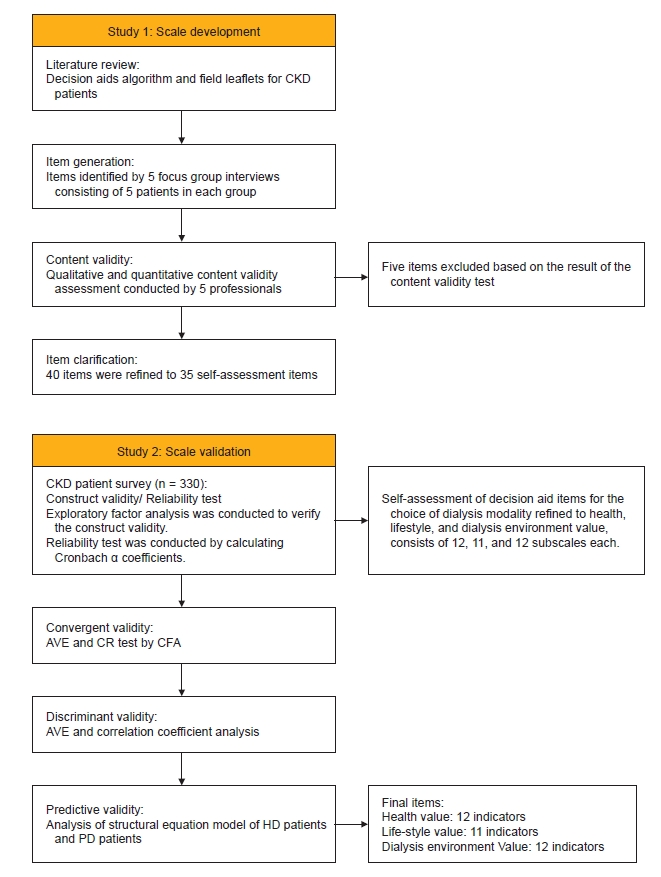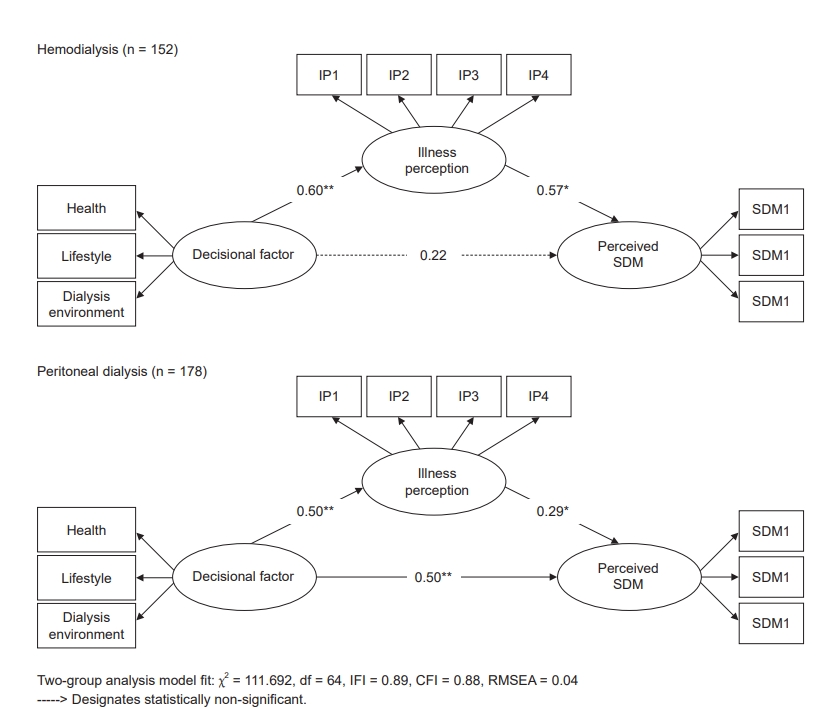1. Thomas B, Wulf S, Bikbov B, et al. Maintenance dialysis throughout the world in years 1990 and 2010.
J Am Soc Nephrol 2015;26:2621–2633.



2. GBD Chronic Kidney Disease Collaboration. Global, regional, and national burden of chronic kidney disease, 1990-2017: a systematic analysis for the Global Burden of Disease Study 2017.
Lancet 2020;395:709–733.


3. Hong YA, Ban TH, Kang CY, et al. Trends in epidemiologic characteristics of end-stage renal disease from 2019 Korean Renal Data System (KORDS).
Kidney Res Clin Pract 2021;40:52–61.



4. Kim SH, Jo MW, Go DS, Ryu DR, Park J. Economic burden of chronic kidney disease in Korea using national sample cohort.
J Nephrol 2017;30:787–793.


5. Roggeri A, Roggeri DP, Zocchetti C, et al. Healthcare costs of the progression of chronic kidney disease and different dialysis techniques estimated through administrative database analysis. J Nephrol 2017;30:263–269.
6. Lee J, Kim YC, Kwon S, et al. Impact of health-related quality of life on survival after dialysis initiation: a prospective cohort study in Korea.
Kidney Res Clin Pract 2020;39:426–440.



7. Porter AC, Lash JP, Xie D, et al. Predictors and outcomes of health-related quality of life in adults with CKD.
Clin J Am Soc Nephrol 2016;11:1154–62.



8. Park JI, Kim M, Kim H, et al. Not early referral but planned dialysis improves quality of life and depression in newly diagnosed end stage renal disease patients: a prospective cohort study in Korea.
PLoS One 2015;10:e0117582.



9. Galla JH. Clinical practice guideline on shared decision-making in the appropriate initiation of and withdrawal from dialysis. The Renal Physicians Association and the American Society of Nephrology.
J Am Soc Nephrol 2000;11:1340–1342.


10. Shay LA, Lafata JE. Where is the evidence?: a systematic review of shared decision making and patient outcomes.
Med Decis Making 2015;35:114–131.


12. Harwood L, Clark AM. Understanding pre-dialysis modality decision-making: a meta-synthesis of qualitative studies.
Int J Nurs Stud 2013;50:109–120.


13. Morton RL, Tong A, Howard K, Snelling P, Webster AC. The views of patients and carers in treatment decision making for chronic kidney disease: systematic review and thematic synthesis of qualitative studies.
BMJ 2010;340:c112.



14. Coronado-Vázquez V, Canet-Fajas C, Delgado-Marroquín MT, Magallón-Botaya R, Romero-Martín M, Gómez-Salgado J. Interventions to facilitate shared decision-making using decision aids with patients in primary health care: a systematic review.
Medicine (Baltimore) 2020;99:e21389.



15. Murray MA, Brunier G, Chung JO, et al. A systematic review of factors influencing decision-making in adults living with chronic kidney disease.
Patient Educ Couns 2009;76:149–158.


16. Polit DF, Beck CT. The content validity index: are you sure you know what’s being reported?: critique and recommendations.
Res Nurs Health 2006;29:489–497.


17. Polit DF, Beck CT, Owen SV. Is the CVI an acceptable indicator of content validity?: appraisal and recommendations.
Res Nurs Health 2007;30:459–467.


18. Schilling LS, Dixon JK, Knafl KA, Grey M, Ives B, Lynn MR. Determining content validity of a self-report instrument for adolescents using a heterogeneous expert panel.
Nurs Res 2007;56:361–366.


19. Kaiser HF. An index of factorial simplicity.
Psychometrika 1974;39:31–36.

20. Hair JF, Black B, Babin BJ, Anderson RE. Multivariate data analysis: global edition. 7th ed. London: Pearson Education; 2010.
21. Cole DA. Utility of confirmatory factor analysis in test validation research.
J Consult Clin Psychol 1987;55:584–594.


22. Cuttance P, Ecob R. Structural modeling by example: applications in educational, sociological, and behavioral research. Cambridge: Cambridge University Press; 1987.
23. Marsh HW, Balla J. Goodness of fit in confirmatory factor analysis: the effects of sample size and model parsimony.
Qual Quant 1994;28:185–217.

24. Hu LT, Bentler PM. Cutoff criteria for fit indexes in covariance structure analysis: conventional criteria versus new alternatives.
Struct Equ Model Multidiscip J 1999;6:1–55.

25. Anderson JC, Gerbing DW. Structural equation modeling in practice: a review and recommended two-step approach.
Psychol Bull 1988;103:411.

26. Kline RB. Software review: software programs for structural equation modeling: Amos, EQS, and LISREL.
J Psychoeduc Assess 1998;16:343–364.

27. Wheaton B, Muthen B, Alwin DF, Summers GF. Assessing reliability and stability in panel models.
Sociol Methodol 1977;8:84–136.

28. Dowdy S, Wearden S, Chilko D. Statistics for research. 3rd ed. Hoboken: John Wiley & Sons; 2011.
29. Campbell DT, Fiske DW. Convergent and discriminant validation by the multitrait-multimethod matrix.
Psychol Bull 1959;56:81–105.


30. Fornell C, Larcker DF. Structural equation models with unobservable variables and measurement error: algebra and statistics.
J Mark Res 1981;18:382–388.

31. Rees J, Chilcot J, Donnellan W, Soulsby L. Exploring the nature of illness perceptions in people with end-stage kidney disease.
J Ren Care 2018;44:19–29.


32. Cassidy BP, Harwood L, Getchell LE, Smith M, Sibbald SL, Moist LM. Educational support around dialysis modality decision making in patients with chronic kidney disease: qualitative study.
Can J Kidney Health Dis 2018;5:2054358118803323.



33. Stacey D, Bennett CL, Barry MJ, et al. Decision aids for people facing health treatment or screening decisions.
Cochrane Database Syst Rev 2011;(10):CD001431.


34. Oh KH. Patient education and care for end-stage kidney disease: one size never fits all.
Kidney Res Clin Pract 2020;39:384–386.



35. Visser A, Dijkstra GJ, Kuiper D, et al. Accepting or declining dialysis: considerations taken into account by elderly patients with end-stage renal disease.
J Nephrol 2009;22:794–799.

36. Lee A, Gudex C, Povlsen JV, Bonnevie B, Nielsen CP. Patients’ views regarding choice of dialysis modality.
Nephrol Dial Transplant 2008;23:3953–3959.


















 PDF Links
PDF Links PubReader
PubReader ePub Link
ePub Link Full text via DOI
Full text via DOI Download Citation
Download Citation Print
Print















